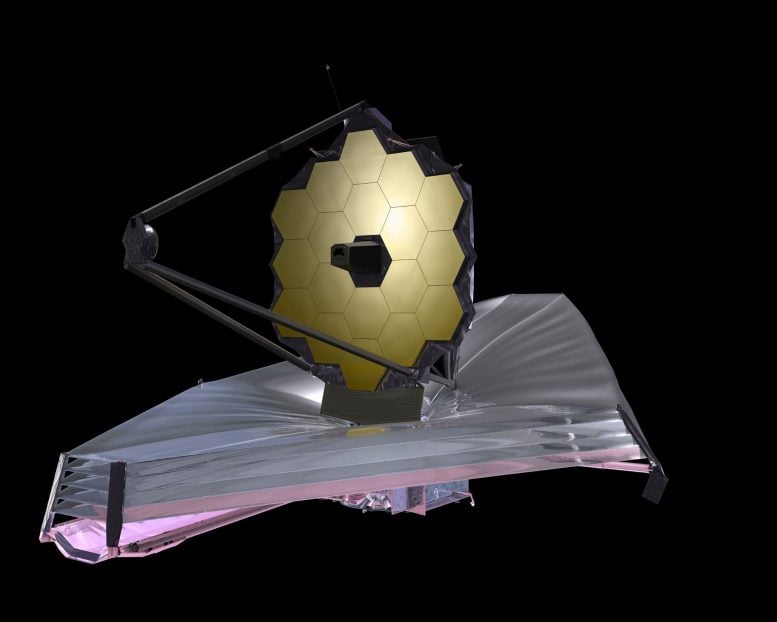
Two new studies from the University of Melbourne will help the largest, most powerful, and complex space telescope ever built to uncover galaxies never before seen by humanity.
The papers are published in The Astrophysical Journal and the Monthly Notices of the Royal Astronomical Society and show that NASA’s James Webb Space Telescope, scheduled for launch late next year, will reveal hidden galaxies.
Powerful lights called ‘quasars‘ are the brightest objects in the universe. Powered by supermassive black holes up to a trillion times the mass of our Sun, they outshine entire galaxies of billions of stars.
Simulations led by Science PhD candidate, Madeline Marshall, show that while even NASA’s Hubble Space Telescope can’t see galaxies currently hidden by these quasars, the James Webb Telescope will be able to get past the glare.
“Webb will open up the opportunity to observe these very distant host galaxies for the first time,” said Ms. Marshall, who conducted her research at the ARC Centre of Excellence in All Sky Astrophysics in 3 Dimensions (ASTRO 3D).
“That can help us answer questions like: How can black holes grow so big so fast? Is there a relationship between the galaxy’s mass and the black hole’s mass, like we see in the nearby universe?”
Although quasars are known to reside at the centers of galaxies, it has been difficult to tell what those galaxies are like and how they compare to galaxies without quasars.
“Ultimately, Webb’s observations should provide new insights into these extreme systems,” said ASTRO 3D co-author Stuart Wyithe of the University of Melbourne.
“The data it gathers will help us understand how a black hole could grow to weigh a billion times as much as our Sun in just a billion years. These big black holes shouldn’t exist so early because there hasn’t been enough time for them to grow so massive.”
The University of Melbourne team collaborated with researchers from the US, China, Germany, and The Netherlands to use the Hubble Space Telescope to try to observe these galaxies.
They then used a state-of-the-art computer simulation called BlueTides, which was developed by a team led by ASTRO 3D distinguished visitor, Tiziana Di Matteo, from Carnegie Mellon University in Pittsburgh, Pennsylvania, US.
“BlueTides is designed to study the formation and evolution of galaxies and quasars in the first billion years of the universe’s history,” said Yueying Ni of Carnegie Mellon University, who ran the BlueTides simulation.
“Its large cosmic volume and high spatial resolution enables us to study those rare quasar hosts on a statistical basis.”
The team used these simulations to determine what Webb’s cameras would see if the observatory studied these distant systems. They found that distinguishing the host galaxy from the quasar would be possible, although still challenging due to the galaxy’s small size on the sky.
They also found that the galaxies hosting quasars tended to be smaller than average, spanning only about 1/30 the diameter of the Milky Way despite containing almost as much mass as our galaxy.
“The host galaxies are surprisingly tiny compared to the average galaxy at that point in time,” said Ms. Marshall.
Read Universe Simulations Show Webb Telescope Can Reveal Distant Galaxies Hidden in Quasars’ Glare for more on this research.
References:
“The host galaxies of z = 7 quasars: predictions from the BlueTides simulation” by Madeline A Marshall, Yueying Ni, Tiziana Di Matteo, J Stuart B Wyithe, Stephen Wilkins, Rupert A C Croft and Jussi K Kuusisto, 5 October 2020, Monthly Notices of the Royal Astronomical Society.
DOI: 10.1093/mnras/staa2982
“Limits to Rest-frame Ultraviolet Emission from Far-infrared-luminous z sime 6 Quasar Hosts” by M. A. Marshall, M. Mechtley, R. A. Windhorst, S. H. Cohen, R. A. Jansen, L. Jiang, V. R. Jones, J. S. B. Wyithe1, X. Fan, N. P. Hathi, K. Jahnke, W. C. Keel, A. M. Koekemoer, V. Marian, K. Ren, J. Robinson, H. J. A. Röttgering, R. E. Ryan Jr., E. Scannapieco, D. P. Schneider, G. Schneider, B. M. Smith and H. Yan, 27 August 2020, The Astrophysical Journal.
DOI: 10.3847/1538-4357/abaa4c
3 Comments
How about we wait until this money pit has actually launched…if it ever does. I don’t want to hear about what it’s going to do. Years behind schedule and Billions over budget. A colossal waste of money so far.
yeah cause designing and launching such a device is like sooooo easy. you’re a schmo.
Large observatories costs a lot. They also return a lot, but for some reason you “don’t want to hear about what it’s going to do”.
Meanwhile most people tend to have their eyes on the target. The article is for them.